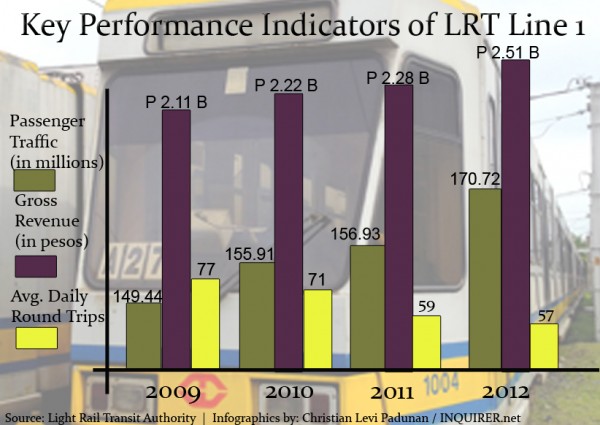MANILA, Philippines – The number of people riding the Light Rail Transit (LRT) lines 1 and 2 steadily increased over the past four years and the number of trains operating decreased because of breakdowns.
LRT line 1, the oldest and longest of the three light railway systems in Metro Manila, has 149.44 million passengers in 2009, according to figures from the Light Rail Transit Authority’s (LRTA) website.
This steadily grew to 155.91 million in 2010 and to 156.93 million in 2011. The number of passengers was at its highest in 2012 with 170.72 million, showing a 13.79 million increase in a year.
The line 1 system currently has 26 operational trains, down from the previous number of 28, Hernando Cabrera, LRTA Board Secretary, told INQUIRER.net in an exclusive phone interview Thursday.
“The ideal number of trains is 33,” he said.
The average number of round trips per day on line 1 has decreased from 77 in 2009 to 71 in 2010. It has further decreased to 59 in 2011 and to 57 in 2012.
Cabrera said that the LRTA, on a given day, estimates the number of passengers and plans how many trains are needed and how many trips each will make to fully serve the riding public from morning until night.
Several factors however, such as train breakdowns, slow trains speeds, system failures, delays, etc., may cause them to miss their target.
Because of the fewer trains plying the tracks, more people had to cram into lesser space.
The Load Factor, a measure of how many people were in the trains, steadily increased over the years from 67.87 in 2009 to 68.98 in 2010.
Trains became further crowded in 2011 with a load factor of 77.32 and 90.21 in 2012.
For the first six months of 2013, the average load factor has already reached 96.87. The highest recorded load factor was in May with 100.34.
Cabrera said that the international standard load factor was 65 to 85, which still makes trains crowded but gave people “just enough” space. He said a measure of seven standing people per square meter was the basis of the international standard.
The number one priority to reduce the load factor was to purchase additional trains that can make more trips, Cabrera said.
“Our current effort right now is to purchase additional trains … so we can bring the number back to 33,” he said.
Meanwhile, the total gross revenues collected increased steadily over the past years correlating with the increase in number of passengers.
In 2009, a total of P2.11 billion was collected in gross revenues. This increased to P2.22 billion in 2010 and to P2.28 billion in 2011.
The gross revenue collected was highest in 2012 at P2.5 billion.
With the LRT line 2 that travels along Aurora Boulevard from Recto station to Santolan station, the amount of passenger traffic and load factor has increased but at a slower pace.
There were 62.09 million passengers for 2009 and 63.36 in 2010. It increased further to 63.83 million in 2011 before jumping higher to 70.33 in 2012.
The load factor in 2009 was 40.34 and actually decreased to 39.91 in 2010. It further decreased to 38.99 in 2011 before jumping higher to 47.98 in 2012.
Average load factor for the first six months of 2013 has reached its highest in the past four years at 59.56.
The average number of round trips per day on line 2 has changed very little over the past four years. In 2009 and 2010 the average was 11. It rose to 13 in 2011 before going back to 11 in 2012.
Cabrera said that the trains on line 2 were relatively newer which made them require less maintenance.
The route was also shorter and there were fewer passengers taking this line which leads to lesser wear and tear on the trains, he added.
Total gross revenue for line 2 has also increased steadily from P838.29 million in 2009 to P857.18 million in 2010.
It decreased slightly to P856.84 million in 2011 but jumped higher to P942.97 million in 2012.
